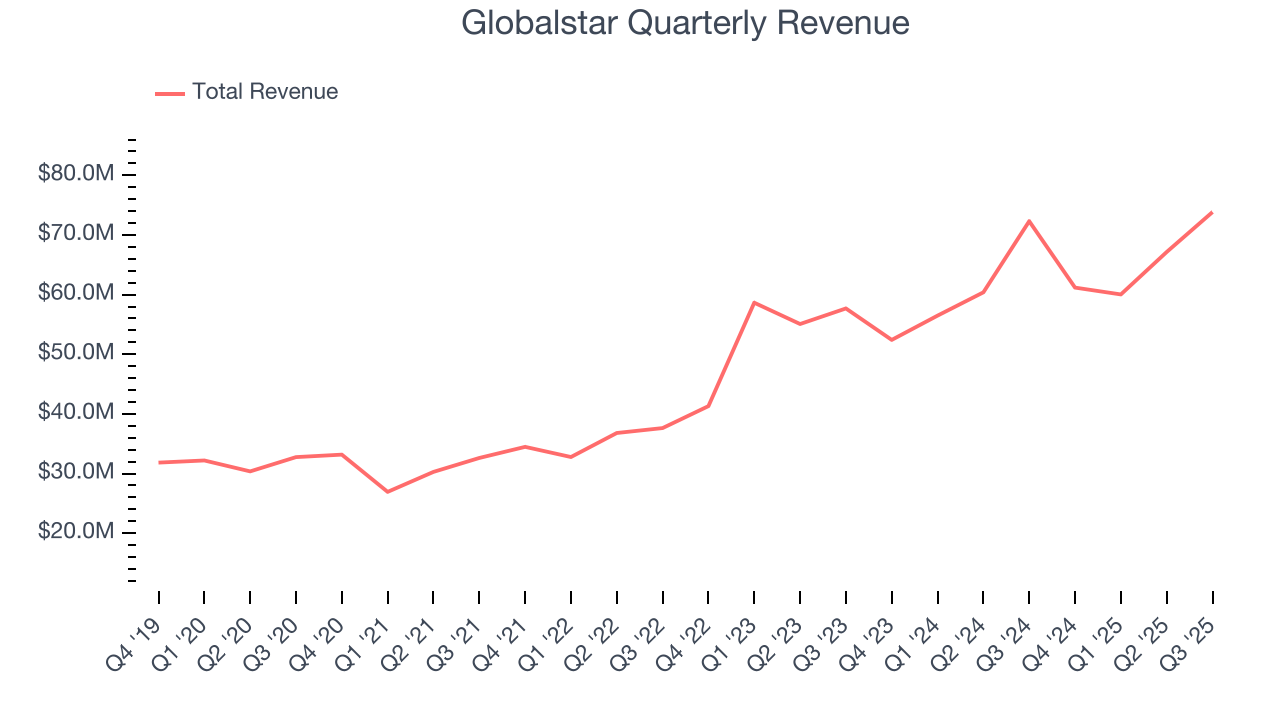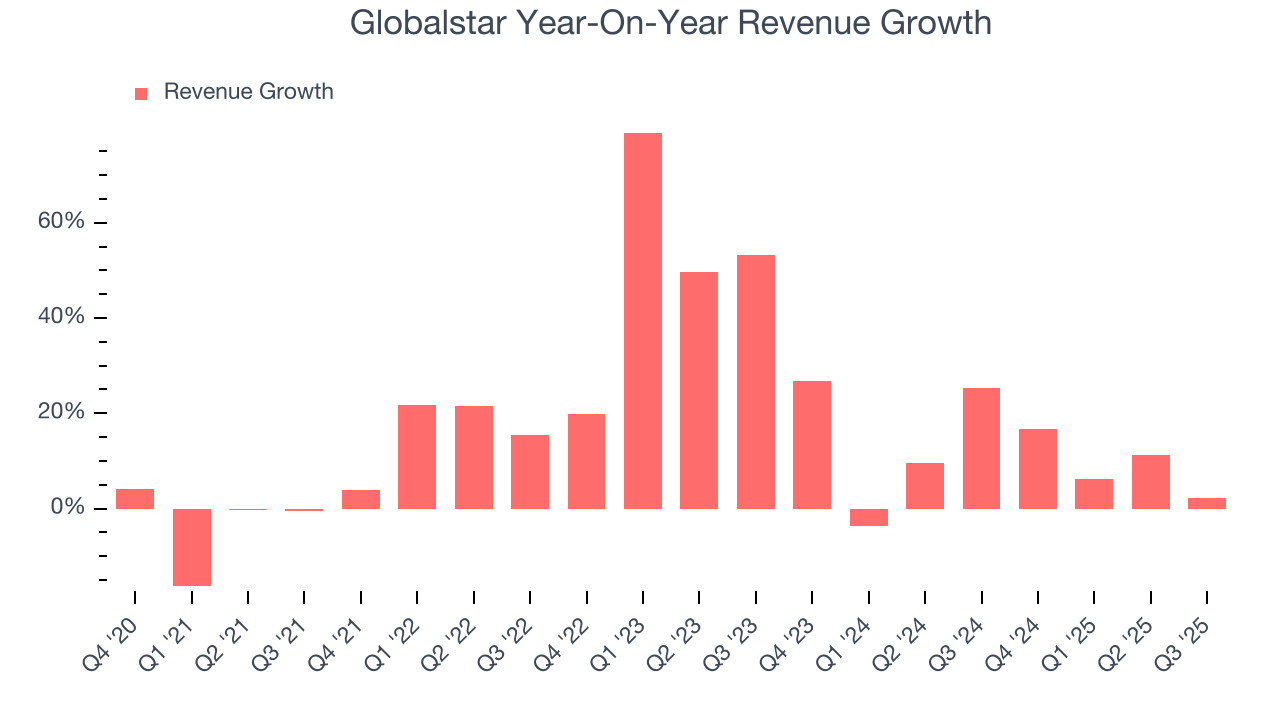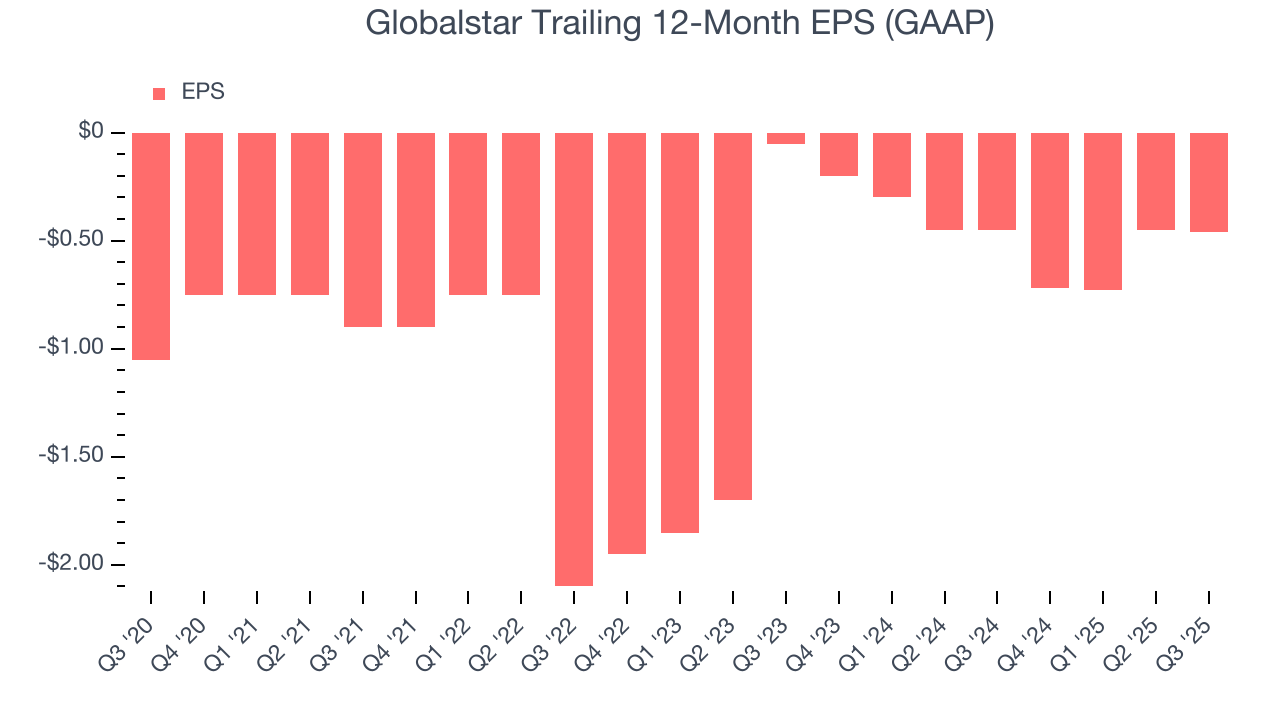
Globalstar (GSAT)
We’d invest in Globalstar. It not only produces heaps of cash but also has improved its profitability, showing its quality is rising.― StockStory Analyst Team
1. News
2. Summary
Why We Like Globalstar
Known for powering the emergency SOS feature in newer Apple iPhones, Globalstar (NASDAQ:GSAT) operates a network of low-earth orbit satellites that provide voice and data communications services in remote areas where traditional cellular networks don't reach.
- Annual revenue growth of 15.6% over the past five years was outstanding, reflecting market share gains this cycle
- Earnings growth has trumped its peers over the last five years as its EPS has compounded at 15.2% annually
- Powerful free cash flow generation enables it to reinvest its profits or return capital to investors consistently, and its improved cash conversion implies it’s becoming a less capital-intensive business


Globalstar is a top-tier company. The price looks reasonable when considering its quality, so this could be a prudent time to buy some shares.
Why Is Now The Time To Buy Globalstar?
Why Is Now The Time To Buy Globalstar?
Globalstar’s stock price of $65.01 implies a valuation ratio of 51x forward EV-to-EBITDA. This price is justified - even cheap depending on how much you believe in the bull case - for the business fundamentals.
It seems like an opportune time to buy the stock if you believe in the long-term prospects of the business.
3. Globalstar (GSAT) Research Report: Q3 CY2025 Update
Satellite communications provider Globalstar (NASDAQ:GSAT) announced better-than-expected revenue in Q3 CY2025, with sales up 2.1% year on year to $73.85 million. The company’s full-year revenue guidance of $272.5 million at the midpoint came in 2.9% above analysts’ estimates. Its GAAP loss of $0.01 per share was $0.02 above analysts’ consensus estimates.
Globalstar (GSAT) Q3 CY2025 Highlights:
- Revenue: $73.85 million vs analyst estimates of $68.94 million (2.1% year-on-year growth, 7.1% beat)
- EPS (GAAP): -$0.01 vs analyst estimates of -$0.03 ($0.02 beat)
- Adjusted EBITDA: $37.57 million vs analyst estimates of $36.06 million (50.9% margin, 4.2% beat)
- The company reconfirmed its revenue guidance for the full year of $272.5 million at the midpoint
- Operating Margin: 13.8%, in line with the same quarter last year
- Free Cash Flow was -$69.38 million, down from $1.90 million in the same quarter last year
- Market Capitalization: $6.48 billion
Company Overview
Known for powering the emergency SOS feature in newer Apple iPhones, Globalstar (NASDAQ:GSAT) operates a network of low-earth orbit satellites that provide voice and data communications services in remote areas where traditional cellular networks don't reach.
Globalstar's satellite network consists of both first and second-generation low-earth orbit satellites positioned to provide coverage between 70° north and 70° south latitude, essentially covering most of the Earth's populated areas. The company maintains ground stations called gateways that communicate with these satellites, creating a seamless network that can authenticate users and establish voice or data connections.
The company offers several key services through its satellite infrastructure. Its Duplex service enables two-way voice and data communications via specialized satellite phones. The SPOT family of products provides personal tracking and emergency notification devices popular with outdoor enthusiasts, having initiated thousands of rescues since launching in 2007. Commercial IoT devices like SmartOne and ST100 allow businesses to track and monitor remote assets such as shipping containers, rail cars, and oil equipment.
In 2022, Globalstar entered a significant partnership with Apple to provide satellite connectivity for emergency SOS features in newer iPhone models. This wholesale capacity service represents an important revenue stream alongside its traditional subscriber-based business. The company is also developing its terrestrial spectrum assets, with licenses in 11 countries covering a population of approximately 814 million people.
Customers span diverse industries including recreation, government, public safety, oil and gas, maritime, utilities, and transportation. A typical user might be an oil rig worker making a call from a remote location, a hiker sending an SOS signal after an injury, or a logistics company tracking shipping containers across oceans. The company generates revenue through activation fees, usage charges, and equipment sales.
Globalstar is expanding its satellite constellation, having contracted with MDA to build up to 26 new satellites with launches beginning in 2025 via SpaceX. The company is also developing two-way commercial IoT products to expand its capabilities beyond tracking to include command and control functions.
4. Satellite Telecommunication Services
Satellite telecommunication is generally buoyed by rising global demand for connectivity in costly-to-connect and remote areas. IoT (Internet of Things) expansion and government-backed space and defense initiatives also help. As advancements in low Earth orbit (LEO) technology happen, companies in the space will have more favorable competitive positions, which could lead to further partnerships with mobile network operators to extend coverage. On the other hand, headwinds include high capital expenditures for satellite deployment as well as regulatory hurdles related to spectrum allocation. Competition from larger players like SpaceX’s Starlink and Amazon’s Kuiper could also intensify over time, especially if tech advancements lead to better unit economics and financial prospects.
Globalstar's primary competitors in the satellite communications market include Iridium Communications (NASDAQ:IRDM), Viasat (NASDAQ:VSAT), and ORBCOMM. The company also faces emerging competition in the direct-to-cellular satellite service space from SpaceX's Starlink and other new market entrants.
5. Revenue Growth
Examining a company’s long-term performance can provide clues about its quality. Any business can put up a good quarter or two, but the best consistently grow over the long haul.
With $262.2 million in revenue over the past 12 months, Globalstar is a small player in the business services space, which sometimes brings disadvantages compared to larger competitors benefiting from economies of scale and numerous distribution channels. On the bright side, it can grow faster because it has more room to expand.
As you can see below, Globalstar’s sales grew at an incredible 15.6% compounded annual growth rate over the last five years. This is an encouraging starting point for our analysis because it shows Globalstar’s demand was higher than many business services companies.

We at StockStory place the most emphasis on long-term growth, but within business services, a half-decade historical view may miss recent innovations or disruptive industry trends. Globalstar’s annualized revenue growth of 11% over the last two years is below its five-year trend, but we still think the results suggest healthy demand. 
This quarter, Globalstar reported modest year-on-year revenue growth of 2.1% but beat Wall Street’s estimates by 7.1%.
Looking ahead, sell-side analysts expect revenue to grow 4% over the next 12 months, a deceleration versus the last two years. This projection doesn't excite us and suggests its products and services will see some demand headwinds. At least the company is tracking well in other measures of financial health.
6. Operating Margin
Operating margin is an important measure of profitability as it shows the portion of revenue left after accounting for all core expenses – everything from the cost of goods sold to advertising and wages. It’s also useful for comparing profitability across companies with different levels of debt and tax rates because it excludes interest and taxes.
Although Globalstar was profitable this quarter from an operational perspective, it’s generally struggled over a longer time period. Its expensive cost structure has contributed to an average operating margin of negative 12.6% over the last five years. Unprofitable business services companies require extra attention because they could get caught swimming naked when the tide goes out.
On the plus side, Globalstar’s operating margin rose by 58.1 percentage points over the last five years, as its sales growth gave it operating leverage. Still, it will take much more for the company to show consistent profitability.

In Q3, Globalstar generated an operating margin profit margin of 13.8%, in line with the same quarter last year. This indicates the company’s overall cost structure has been relatively stable.
7. Earnings Per Share
Revenue trends explain a company’s historical growth, but the long-term change in earnings per share (EPS) points to the profitability of that growth – for example, a company could inflate its sales through excessive spending on advertising and promotions.
Although Globalstar’s full-year earnings are still negative, it reduced its losses and improved its EPS by 15.2% annually over the last five years. The next few quarters will be critical for assessing its long-term profitability. We hope to see an inflection point soon.

Like with revenue, we analyze EPS over a shorter period to see if we are missing a change in the business.
For Globalstar, its two-year annual EPS declines of 200% mark a reversal from its (seemingly) healthy five-year trend. These shorter-term results weren’t ideal, but given it was successful in other measures of financial health, we’re hopeful Globalstar can return to earnings growth in the future.
In Q3, Globalstar reported EPS of negative $0.01, down from $0 in the same quarter last year. Despite falling year on year, this print easily cleared analysts’ estimates. Over the next 12 months, Wall Street is optimistic. Analysts forecast Globalstar’s full-year EPS of negative $0.46 will reach break even.
8. Cash Is King
Free cash flow isn't a prominently featured metric in company financials and earnings releases, but we think it's telling because it accounts for all operating and capital expenses, making it tough to manipulate. Cash is king.
Globalstar has shown terrific cash profitability, enabling it to reinvest, return capital to investors, and stay ahead of the competition while maintaining an ample cushion. The company’s free cash flow margin was among the best in the business services sector, averaging 23.8% over the last five years. The divergence from its underwhelming operating margin stems from the add-back of non-cash charges like depreciation and stock-based compensation. GAAP operating profit expenses these line items, but free cash flow does not.
Taking a step back, we can see that Globalstar’s margin expanded by 30 percentage points during that time. This is encouraging because it gives the company more optionality.

Globalstar burned through $69.38 million of cash in Q3, equivalent to a negative 94% margin. The company’s cash flow turned negative after being positive in the same quarter last year, but we wouldn’t put too much weight on the short term because investment needs can be seasonal, causing temporary swings. Long-term trends trump fluctuations.
9. Return on Invested Capital (ROIC)
EPS and free cash flow tell us whether a company was profitable while growing its revenue. But was it capital-efficient? A company’s ROIC explains this by showing how much operating profit it makes compared to the money it has raised (debt and equity).
Although Globalstar has shown solid business quality lately, it struggled to grow profitably in the past. Its five-year average ROIC was negative 4%, meaning management lost money while trying to expand the business.

We like to invest in businesses with high returns, but the trend in a company’s ROIC is what often surprises the market and moves the stock price. Over the last few years, Globalstar’s ROIC has increased. This is a good sign, but we recognize its lack of profitable growth during the COVID era was the primary reason for the change.
10. Balance Sheet Assessment
Globalstar reported $346.3 million of cash and $564.8 million of debt on its balance sheet in the most recent quarter. As investors in high-quality companies, we primarily focus on two things: 1) that a company’s debt level isn’t too high and 2) that its interest payments are not excessively burdening the business.

With $134.1 million of EBITDA over the last 12 months, we view Globalstar’s 1.6× net-debt-to-EBITDA ratio as safe. We also see its $29.66 million of annual interest expenses as appropriate. The company’s profits give it plenty of breathing room, allowing it to continue investing in growth initiatives.
11. Key Takeaways from Globalstar’s Q3 Results
It was good to see Globalstar beat analysts’ EPS expectations this quarter. We were also excited its revenue outperformed Wall Street’s estimates by a wide margin. Zooming out, we think this was a solid print. The stock traded up 3.2% to $49.75 immediately after reporting.
12. Is Now The Time To Buy Globalstar?
Updated: November 25, 2025 at 11:50 PM EST
Before making an investment decision, investors should account for Globalstar’s business fundamentals and valuation in addition to what happened in the latest quarter.
There is a lot to like about Globalstar. First of all, the company’s revenue growth was exceptional over the last five years. And while its relatively low ROIC suggests management has struggled to find compelling investment opportunities, its powerful free cash flow generation enables it to stay ahead of the competition through consistent reinvestment of profits. On top of that, Globalstar’s rising cash profitability gives it more optionality.
Globalstar’s EV-to-EBITDA ratio based on the next 12 months is 50x. Looking at the business services landscape today, Globalstar’s fundamentals really stand out, and we like it at this price.
Wall Street analysts have a consensus one-year price target of $67.50 on the company (compared to the current share price of $60.29), implying they see 12% upside in buying Globalstar in the short term.










